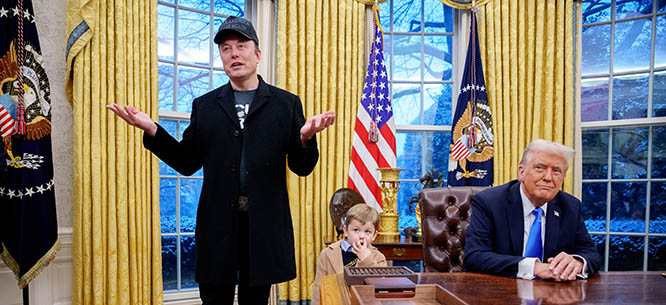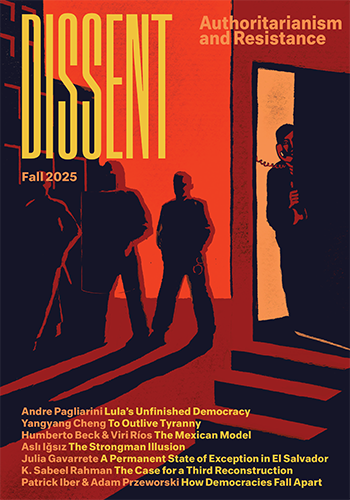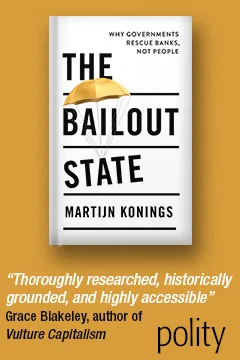Fissures in Trumpworld?
Fissures in Trumpworld?
There will surely be turf wars and palace intrigue within the administration, but there is little reason to think that its core figures will fracture in the pursuit of their basic goal: to break the twentieth-century state.

The onslaught of the first weeks of Donald Trump’s second term was predictable, if no less unsettling for that. It was always clear that the goal was to overwhelm the opposition with a blitzkrieg of executive action—“flood the zone” and “shock and awe” were the terms floated by Trump’s allies—before momentum bogged down in Congress and the courts. On a psychological level it has been effective. On the question of long-term institutional success, the answer is murkier.
The most surprising element has been the leading role played by Elon Musk’s Department of Government Efficiency (DOGE), which has been the tip of the spear in the war against the federal government. Prior to the inauguration, smart money held that DOGE would be more bark than bite, a glorified blue-ribbon commission designed as a safe landing spot for an important but volatile Trump ally. It has been apparent that DOGE would be something far more significant since news broke at the beginning of February that Musk’s team had gained access to the Treasury Department’s payments system. In exchange for over $250 million in campaign contributions, Musk may have purchased de facto fiscal sovereignty over the U.S. government—even if the scope and durability of DOGE’s cuts remain uncertain.
Musk’s unexpected prominence within the administration is only the most visible symbol of the much-discussed emergence of the “tech right.” In recent months, a great deal of commentary has focused on the supposed split between this cohort and the older MAGA populists. Dissension spilled into public view in late December with a dispute over H-1B visas for high-skilled immigrant workers. Musk and his allies won that battle to keep the program intact, although Vivek Ramaswamy’s impolitic comments about the laziness of American-born workers helped trigger his ouster as co-head of DOGE. More recently, Trump’s former advisor Steve Bannon has taken to the airwaves as an outspoken champion of the populists and scourge of the techies. The two camps laid out their narratives in dueling New York Times podcast interviews with Bannon and venture capitalist Marc Andreessen (who, unlike Bannon, was eager to downplay any enmity).
Trump’s opponents have an understandable desire to find internal fissures within his administration. And here the contrasts write themselves: Middle America versus Silicon Valley, workers versus billionaires, protectionism versus libertarianism, Fordist nostalgia versus Promethean futurism. These contrasts speak to some real tensions, above all between the predatory capitalism of Trump’s policy agenda and the class composition of his electoral coalition.
But an exclusive focus on fissures can cause us to lose sight of what binds the administration together. For most of the key figures slotted into one or the other camp share a deep set of personal connections and ideological commonalities. And the notion that Musk and the tech right represents a sharp break from true MAGA populism rests on a misunderstanding about what MAGA has been from the beginning.
Instead of starting from a set of stylized contrasts about what we assume the tech and populist right represent, we should begin by examining the actual people under discussion. Who are we talking about, and what are their histories?
The narrative about the tech industry’s rightward swing can be misleading in a few ways. For one, it tends to occlude that this is overwhelmingly a phenomenon of founders and upper management rather than the industry as a whole. (In Andreessen’s telling, increased labor militancy among tech workers was a key radicalizing force on their bosses.) Even among the set of tycoons who sat behind Trump at his inauguration, most are clearly reacting to the political shift rather than driving it—notwithstanding Mark Zuckerberg’s characteristically cringeworthy attempt to tap into the new mood by calling for more “masculine energy” in the corporate world.
Conversely, some of the key figures on the tech right have been reactionaries since the beginning—above all Peter Thiel, godfather of the movement, and his longtime sidekick David Sacks, now Trump’s “crypto and AI czar.” Likewise, Andreessen has held substantively right-wing views on markets and regulation for as long as he has been commenting publicly on politics; the likely reason that he continued to identify as a Democrat for as long as he did is simply that his early career coincided with the peak of the party’s neoliberal era. Musk does seem to have gone through a genuine process of ideological transformation via Twitter brain-poisoning, yet he has moved not simply toward standard-issue libertarianism but to a set of racial and demographic preoccupations that are something of a family inheritance. (It is conspicuous that the core of the tech right—Musk, Thiel, Sacks—consists of South African expats for whom skepticism about multiracial democracy was mother’s milk.)
On the other side, who represents MAGA? Two Bannon allies often mentioned in the media are deputy chief of staff Stephen Miller and budget director Russell Vought, both longtime Beltway operatives rather than transplants from the private sector. Yet recent reporting in the Times has detailed the links that each of them has to Musk and the tech camp. Miller became close to Musk during Trump’s interregnum and helped guide the billionaire’s political donations; Miller’s wife Katie now works for DOGE. When Vought was in political disfavor following the public backlash to Project 2025, Musk and Ramaswamy helped engineer his appointment as budget director. And both Miller and Vought have been key guides for Musk in planning his war on the federal government.
The figure typically cited as the populist wing’s champion in the administration is Vice President JD Vance. No doubt this stems largely from his origin story, even if attentive critics of Hillbilly Elegy have always noted that the book’s depiction of a white working class held back by cultural pathology was far from uncongenial to economic elites. Vance has also offered some gestures of support for organized labor (which not coincidentally came during his brief political career in Ohio, where organized labor remains electorally significant). But there is no real reason to view him as a counterweight to the tech oligarchs.
Vance’s career before entering politics was as a venture capitalist, and his key patron was Peter Thiel, who both provided his entree into Silicon Valley and later funded his Senate campaign. Vance has repeatedly shown his willingness to adapt to those in a position to further his ambitions, and all available evidence suggests that he has a closer attachment to the Silicon Valley billionaire class that nurtured him than to the Appalachian working class from which he escaped. When the historian Rick Perlstein reported Marc Andreessen’s verdict on the Middle American underclass (“I’m glad there’s OxyContin and video games to keep those people quiet”), Vance rushed to the defense of Andreessen, another early patron in his VC days. His maiden foreign speech as vice president, just before his better-publicized Munich speech, was a call in Paris for AI deregulation, which earned him plaudits from old-school Reaganites for its newfound adherence to free-market orthodoxy.
As this brief prosopography indicates, it is misleading to imagine two distinct factions at the core of the administration’s domestic and economic policy. Any administration will have internal conflicts and palace intrigues—this one more than most—and there may be more salient divisions when it comes to foreign policy or social issues. But what stands out about the group just surveyed is its cohesion. These figures have a rich history of personal connection and professional collaboration.
What is the ideological basis for this cohesion? Answering this question becomes needlessly difficult if we accept the characterization of MAGA put forward by many of its propagandists: that Trumpism is fundamentally populist not just in its social base but in its substantive agenda, combining a robust welfare state with nativism and social conservatism. Such propagandists typically grant that Trump’s first term didn’t live up to this promise, but blame it on the good king’s wicked establishment advisors; once freed from these evil influences, MAGA will finally achieve its telos. Opponents on the left sometimes echo such a view of Trumpism as “Herrenvolk social democracy,” with the perceived electoral potency of such a formula reflecting anxieties that the left is weighing down its populist economic message with unnecessary cultural and identitarian baggage.
If this were an accurate view of MAGA, then the conflict with the tech right’s implacable hostility to the welfare and regulatory state would indeed be insoluble. So the first step in understanding MAGA’s rapprochement with Silicon Valley is recognizing that genuine economic populism has always been toothless and irrelevant within the Trump coalition.
The history of the last decade bears out this irrelevance. Although Trump’s willingness to rhetorically defy the conventions of traditional Republican austerity politics was key to his initial electoral success, he governed as a conventional Republican in office, with an agenda centered on tax cuts, deregulation, and Obamacare repeal. Despite efforts by his apologists to blame this on Mitch McConnell and Paul Ryan in Congress, the figures to whom Trump gravitated as his term wore on were, if anything, even more dogged market fundamentalists. (One of them, the supply-side evangelist Larry Kudlow, has also shaped Trump’s second-term staffing and agenda through his America First Policy Institute.)
The Biden administration attempted to build bipartisan support by following through on some of Trump’s unfulfilled populist promises, but its scant success illustrated the lack of any stable constituency for such measures among the MAGA political class. An infrastructure bill, whose disappearance from Trump’s first-term agenda had become a running joke, passed narrowly with votes from moderate rather than MAGA Republicans; the expanded child tax credit, potential springboard for a pro-family agenda, died on the vine without attracting any significant Republican support. In Trump’s second term, the center of gravity has shifted from the seedier wing of the FIRE industries to the fashier wing of Silicon Valley, but the agenda remains much the same: tax cuts and deregulation, most likely paid for with steep cuts to Medicaid.
At the same time, Trump has expanded his share of the working-class vote across three electoral cycles, and the longer-term trend of class dealignment has continued apace. This hardly means that workers are indifferent to economic outcomes: it is crucial to bear in mind that Trump’s first term has been remembered as a period of relative economic prosperity sandwiched between the Great Recession and the COVID-19 shock. (In this regard he looks a bit like Bill Clinton, whose substantively anti-worker policies were likewise cushioned by an economic boom.) But the basic lesson that the right took from Trump’s record is that successful populist politics doesn’t actually require economic follow-through, so long as you kick up enough culture-war dust.
The would-be MAGA economic populists also proved to be cheap dates. The case of Steve Bannon is illustrative. He joined the administration in 2016 calling for tax hikes on high-income earners and a trillion-dollar infrastructure bill. Trump swiftly abandoned the Bannonite agenda, but Bannon never abandoned Trump. How could he when MAGA is his meal ticket (in more ways than one), and his overstated reputation as Trump’s Thomas Cromwell the only thing separating him from a hundred other professional YouTube shouters? Despite his railing against the influence of the oligarchs, Bannon has already announced his unconditional support for Trump, regardless of what the president does in his second term. With such champions as these, it’s unsurprising that the populists have never exerted any real influence on economic policy.
If battles within MAGA over taxes and regulation have always resulted in easy victories for the plutocrats, immigration might seem to pose a more intractable challenge. The basic conflict between MAGA’s foundational hostility to mass migration and the GOP donor class’s need for immigrant labor is familiar enough to need no elaboration. The outlines of a rapprochement are nonetheless visible.
The tech right may demand a carveout for its engineers and coders, but it has shown no objection to a broader crackdown on working-class immigrants who don’t affect its bottom line. In some cases this may reflect real xenophobia; Musk is doing a very convincing impression of someone genuinely obsessed with racial and cultural cohesion. In other cases it may reflect a pragmatic acceptance of anti-migrant sentiment as a kind of socialism of fools—a lone concession to economic populism that frees the right from having to moderate on economics in any other way.
For the broader donor class, a maximalist attempt to deport all the undocumented would indeed pose serious problems (which is one reason to doubt that it will happen). But a more selective campaign of terror, in which the ubiquitous threat of deportation produces a docile workforce afraid to complain about labor conditions or wage theft, suits their interests perfectly well. A campaign of high-profile deportation raids in blue cities that only sporadically targets the red hinterland would combine culture war and labor discipline.
Thus there is little reason to imagine that the core of the administration is destined to fracture over either economic policy or immigration. On economic policy, the pro-worker elements of MAGA are too weak to put up a fight. On immigration, the tech right can afford to make significant concessions to nativism—and may not even view them as concessions. But there is also a positive program that unites figures ranging from Musk and Andreessen to Vance and Bannon, and that connects them back to the broader history of the American right.
DOGE’s attack on the federal government has been startling for obvious reasons: its rapidity, its commandeering of the government’s payments infrastructure, its implementation by a staff of pubescent Twitter Nazis. These novel aspects can disguise the fact that some version of DOGE’s project would have been central to any iteration of the second Trump administration. Well before Musk seized the spotlight, the institutional conservative movement had produced two rival plans for the second Trump term: the Heritage Foundation’s notorious Project 2025 and the lower-key but equally important effort by the America First Policy Institute. Both plans made purging the federal civil service a central priority. And in practice the assault has been a joint effort: USAID is being dismantled by DOGE, the Consumer Financial Protection Bureau by Vought (formerly of Project 2025), the Department of Education by its own leader Linda McMahon (formerly of AFPI). Whether Musk remains in the driver’s seat or falls from favor, the basic project will remain central to Trump’s presidency.
The alleged populist wing does not dissent in the slightest from this project. On the contrary, Bannon has been demanding the “deconstruction of the administrative state” since he came on the scene, while Vance has called on Trump to “fire every single mid-level bureaucrat, every civil servant in the administrative state” and to defy court orders if needed to accomplish it. Innumerable Substackers now offer garbled denunciations of the “deep state” and the managerial class, appropriating categories originally applied to intelligence operatives and corporate executives to justify the purging of park rangers and veterans’ affairs caseworkers.
What all these figures disparage as the “deep state” is simply the twentieth-century state, the accrued legacy of progressivism, the New Deal, and the Great Society. And for all its claims to break with conservative orthodoxy, the self-described New Right’s foundational hostility to the twentieth-century state makes it continuous with previous iterations of what Daniel Schlozman and Sam Rosenfeld call the “Long New Right.” When partisans of the latest New Right contrast the sophisticated anti-managerialism of JD Vance with the mere “orthodox MAGA” of Donald Trump, they have it precisely backward. The New Right’s hostility to the twentieth-century state is its most familiar feature (its bible is over eight decades old), while the most heterodox member of the Trump administration is Trump himself—which is why so much effort has been expended over the last four years to surround him with the proper ideological cadres for his return to power.
The Long New Right’s quest to break the twentieth-century state has occasioned more frustration than triumph. Ronald Reagan came the closest to winning ideological hegemony for its cause. But even he was never able to build a majority sufficient to undo the New Deal and Great Society legislatively, and Paul Ryan was the last figure to really attempt the project. Conservative Republicans and neoliberal Democrats alike would nibble away at the state, but its basic institutions remained stubbornly on the books—above all because the public at large did not share the right’s zeal to undo them. And so the Long New Right took on a pattern familiar from revolutionary movements of the left: new generations of insurgents toppled their elders only to be deemed traitorous accommodationists in turn. These cycles never involved much genuine reevaluation of the movement’s substantive goals. The charge against “RINOs” and “Conservatism Inc.” was rather that they were unwilling to fight ruthlessly enough in support of these goals. Hence the familiar mantra justifying allegiance to Trump: he fights.
The second Trump term can be understood as a culmination of this history. The aim is no longer to build a congressional majority to legislate the twentieth-century state away, but rather to end the need for majority legislation altogether and dismantle the state by executive fiat. This is why the administration’s key gambit thus far, pushed especially by Musk and Vought, has been impoundment, the executive’s unilateral and illegal refusal to spend money appropriated by Congress. The view of Trump as populist herald of Herrenvolk social democracy was always naive. The Long New Right saw something else in him: the battering ram that could be used to break the twentieth-century state by force after the decades-long failure to achieve this goal by democratic persuasion.
There will surely be turf wars and palace intrigue within the administration, but there is little reason to think that its core figures will fracture in the pursuit of this basic goal. To say that these figures are ideologically cohesive, however, is not to say that they will be successful. The continuing fact of class dealignment means that Trump’s 77 million voters are more dependent than ever on state provision. The twentieth-century state came into being for a reason and endured, however partially, for a reason; gutting it would unleash forces that no one can predict or control. If the project of Trump’s second term fails, it will not be because its protagonists turned on one another, but rather because the ice broke beneath their feet.
Daniel Luban teaches political science at Columbia.






